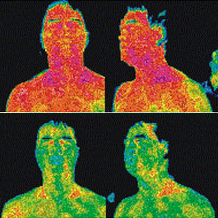

Historical Tales | News | Vampires | Zombies | Werewolves
Virtual Academy | Weapons | Links | Forum
 |
 |
Historical Tales | News | Vampires | Zombies | Werewolves Virtual Academy | Weapons | Links | Forum |
Return to Part II
Body Temperature & Dormancy
 |
|
Before (top) and after (bottom) thermal imaging of the transformation |
Zombies also tend to sweat more than vampires—due in large part to their higher temperature and poorer regulation habits—but it's mostly a case of overactive sweat glands, which are likely a physiological response to their inability to urinate. The fact that they drool profusely could be another form of fluid removal.
Another vampiric trait zombies share is the ability to survive being frozen solid, along with the act of voluntary dormancy. However, given their constant state of decay, how long they can hibernate depends greatly on the surrounding temperature: a matter of weeks in the cold; mere days in the heat.
 |
| A frozen zombie discovered in North Dakota; 1972 |
 |
|
The bottom panel reflects the reality of both vampiric and zombic ovaries. Worse, the latter also develop pus-filled cysts over time, followed by necrosis. |
A long-held, common misconception is that zombies are immortal, when in actuality the vast majority of them live less than a year. It is possible to determine a zombie's age based on their external appearance—specifically, their level of decomposition, also known as necrotic degradation.
 |
| The three stages of necrotic degradation |
|
Stage I: 1-3 months. The skin is mottled, flaking, peeling and covered with open sores.
Stage II: 4-6 months. The ears, lips, nose and eyelids are rotting away; loss of skin, teeth, hair, nails, fingers and toes. Bacterial breakdown of dead tissue causes bloating and eventual splitting of epidermis. Stage III: 7-9 months. Body is emaciated, with large areas of exposed muscle and bone; loss of facial features, breasts, genitals and likely limbs. Outer tissues are dry, tough and leathery. Most of the hair and teeth are gone, and one or both eyes fall out. Another interesting difference from vampires is that older zombies do not experience any significant spinal curvature. |

|

|
| Stage II | Stage III |
|
The Stage II zombie retains both eyes, although the nose is already gone (along with most of the hair), the area around the mouth is beginning to undergo significant necrosis, and much of the soft tissue has become horrifically swollen. Still, the zombie has a large amount of intact flesh and some jagged teeth left, making it a formidable adversary.
|
Both eyes, ears and lips, and all of the nose and teeth are gone in the Stage III zombie, with mere tufts of dead hair glued to what's left of its crusted scalp. Having only its sense of smell and very little muscle strength and touch sensation left, such a zombie is likely to be malnourished and confused. In the old days, people often made sport of the poor wretches, taunting them with sticks and rocks and knocking them down. But as many of these pranksters found out, the Stage III zombie still had some power in its jaws and was capable of clamping down on a forearm and spreading the virus in an instant.
|
 |
| The remains of a canine infected with zombism |
Even vampires can be infected, though the transformation process takes a day or so longer due to their slower metabolism. The resulting abomination is known as a vampirozombie (or zompire), and it retains some of its vampiric characteristics, such as fangs and night vision. Everything else is rather muted: a vampirozombie will gnaw flesh as it drinks blood, it can barely feel its numbed skin burning in the sun, and its dying brain is not as prone to seizures. They are, however, still quite blinded by bright light, since their pupils remain fully dilated. Their fast-twitch muscles also make them somewhat more agile than normal zombies, but their lack of coordination prevents them from sprinting and jumping.
Interestingly, only vampires can become vampirozombies—which explains the old saying that the zombie is the last stop on the Undead Express. Even if a vampire did bite a zombie, the latter would not turn. It's not really known why, but it's speculated that zombies have far too many toxins in their bodies for the vampirism virus to function properly. As for how vampires can become infected with zombism when they're immune to most other viruses, it's believed that HZV's genetic similarities to HVV allow it easy access into vampiric cells.
 |
|
While his obsession with twins is well known, Josef Mengele also had a morbid fascination with the undead. |
Needless to say, vampirozombies were extremely rare (outside of laboratory experiments), as most vampires knew to stay well away from their undead brethren.
As for what would happen to a normal human infected with both viruses at the same time, heinous experiments performed by Nazi scientists have shown that zombification occurs in most surviving subjects, since that particular process is much more rapid than vampirism. In order for someone to become a hybrid, they first must be infected with vampirism, then zombism after they've entered the coma. What few subjects experienced immunity to one virus always succumbed to the other. Variations of these experiments included transplanting vampiric and zombic organs and limbs onto humans and vice versa—even grafting entire individuals together—with predictably disastrous results.
The preceding information brings up another question: do the vaccines work on animals and vampires? Seeing as how vaccines are basically killed or weakened virions, the answer is yes. Immune globulin, however, is a different matter entirely, since human antibodies that target the viruses are largely ineffective in other organisms. As a result, the vaccines must be administered before infection takes place. Immune globulin can be created for individual species, but the cost and manpower of such an endeavor is better spent on humans. After all, they pose the biggest danger when turned.